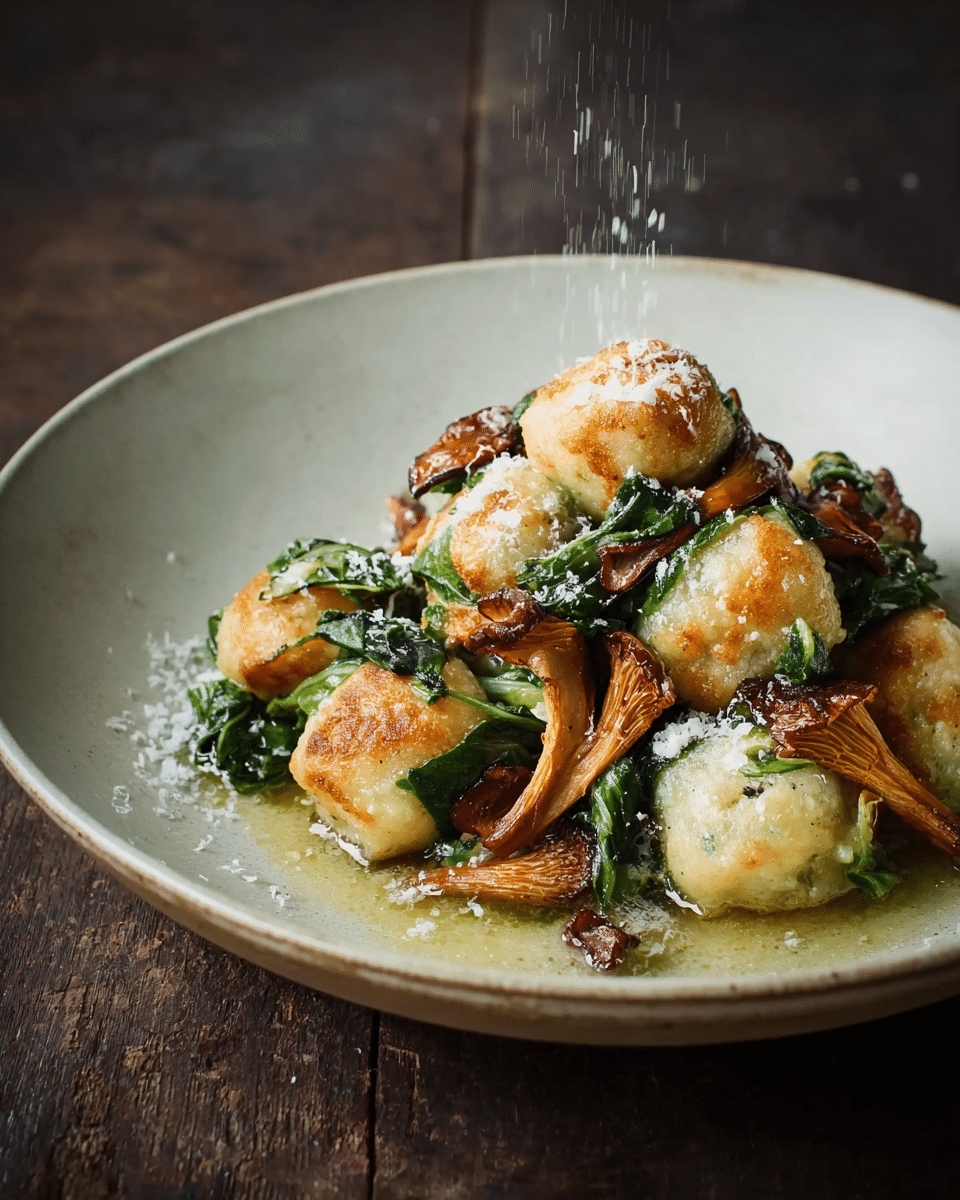Ricotta gnudi with Swiss chard and girolle mushrooms is a refined interpretation of a classic Tuscan pasta dish, offering pillowy dumplings that are tender, delicate, and creamy. The gnudi themselves are essentially “naked ravioli,” made from a mixture of ricotta, eggs, and lightly pressed Swiss chard, which allows the natural sweetness of the greens to shine through. Each dumpling is dusted in semolina to give a subtle rustic crust and cooked to a cloud-like consistency that melts in the mouth. Complementing the gnudi, girolle mushrooms are lightly sautéed in butter and olive oil, adding earthy, woodsy notes and a meaty texture, while a buttery lemon sauce ties the dish together, infusing each bite with silky richness and bright, fresh acidity. The dish delivers a sophisticated interplay of textures and flavors: soft gnudi, tender yet slightly crisp chard stems, and tender mushrooms coated in a velvety, aromatic sauce. It’s an elegant vegetarian entrée that balances indulgence with wholesome ingredients and is equally suited as a main course or an upscale starter.
Full Recipe:
Ingredients
-
500 g Swiss chard
-
250 g ricotta
-
2 eggs
-
10 g Parmesan, finely grated (plus extra for garnish)
-
20 g Pecorino, finely grated
-
Freshly grated nutmeg (¼)
-
Salt, to taste
-
Freshly ground black pepper, to taste
-
3 tbsp 00 flour
-
200 g semolina, for dusting
-
100 g girolle mushrooms (chanterelles)
-
1 tbsp olive oil
-
100 g unsalted butter
-
Lemon juice, to taste
Directions
-
Wash the Swiss chard thoroughly, separating the stems from the leaves. Chop the leaves finely.
-
Blanch the chopped leaves in boiling salted water for 1–2 minutes, then drain and press out excess moisture using a kitchen towel or cheesecloth.
-
In a large mixing bowl, combine the ricotta, blanched and drained chard, eggs, grated Parmesan and Pecorino, a pinch of nutmeg, and season with salt and freshly ground black pepper. Mix gently until smooth.
-
Fold in the 00 flour to help bind the mixture. Cover the bowl and refrigerate for at least one hour or overnight to firm up the gnudi.
-
Dust a clean surface with semolina. Shape the chilled mixture into small, oval dumplings about the size of a large walnut. Roll each gnudi in semolina to coat all sides.
-
Bring a large pot of salted water to a gentle simmer. Cook the gnudi in batches until they float to the surface, approximately 2–3 minutes. Remove with a slotted spoon and place on a towel-lined plate to drain.
-
Clean the girolle mushrooms and trim stems if needed. Heat olive oil and half the butter in a skillet over medium heat. Sauté the mushrooms for 3–4 minutes until tender and lightly golden. Remove and set aside.
-
In the same skillet, melt the remaining butter and swirl in a little pasta water to create a smooth sauce. Add a squeeze of lemon juice to brighten the flavors.
-
Gently toss the cooked gnudi in the butter-lemon sauce, being careful not to break them. Return the sautéed mushrooms to the skillet and combine gently.
-
Taste and adjust seasoning with salt, pepper, or additional lemon juice if desired.
-
Serve immediately, garnished with extra grated Parmesan or Pecorino and torn chard leaves or microgreens for color and freshness. Optional sides include a light salad, steamed vegetables, or crusty bread to complement the dish.
Nutrients
-
Calories: Moderate—ricotta and butter contribute richness, balanced by protein from eggs and cheese
-
Protein: Good—ricotta, eggs, Parmesan, and Pecorino provide satisfying protein
-
Fat: Rich—primary fats from butter and cheeses
-
Carbohydrates: Modest—mostly from semolina dusting and flour in the gnudi
-
Fiber: Present—Swiss chard adds fiber and micronutrients
-
Micronutrients: Vitamin K, Vitamin A, magnesium from Swiss chard; calcium from ricotta and hard cheeses; riboflavin, phosphorus from mushrooms
Why This Recipe Stands Out
This rendition of ricotta gnudi stands out for its remarkable balance of simplicity and refinement. The gnudi are crafted from just a few high-quality ingredients—ricotta, eggs, a touch of flour, and finely pressed Swiss chard—but the result is extraordinarily light and supple dumplings that offer a delicate chew and creamy interior. The addition of girolle mushrooms introduces an earthy, slightly peppery note, while the butter sauce, emulsified with a splash of pasta water and brightened with lemon juice, envelops each gnudi in a silky, luxurious coating. The dish harmonizes rustic Tuscan traditions with elegant techniques, achieving a presentation that is both visually appealing and satisfying to the palate. The contrast of textures—from the tender dumplings to the lightly crisped chard stalks and the meaty mushrooms—creates an engaging mouthfeel that elevates the dish beyond ordinary vegetarian pasta. Its refined flavor profile makes it ideal as a main course for dinner or as a sophisticated starter at a special occasion.
The Benefits of the Ingredients
Each component of this dish contributes both taste and nutritional value. Swiss chard provides vibrant color, dietary fiber, and a wealth of micronutrients, including vitamins A, C, and K, as well as magnesium and iron. Ricotta introduces creamy richness while supplying protein and calcium without the heaviness of aged cheeses alone. Parmesan and Pecorino enhance the umami depth of the gnudi while contributing additional calcium and flavor complexity. Girolle mushrooms offer antioxidants, B-vitamins, and a subtle earthiness that complements the greens and cheeses. The use of butter and olive oil adds richness and mouthfeel, while lemon juice balances the dish with bright acidity, cutting through the fats and enhancing all other flavors. Together, these ingredients create a nutrient-dense vegetarian meal that is both indulgent and health-conscious, providing protein, vitamins, minerals, and beneficial phytonutrients.
Cooking Tips
To achieve the perfect texture, it is essential to remove excess moisture from the blanched Swiss chard before combining it with the ricotta. This ensures the gnudi hold their shape during cooking and avoids a soggy result. Allowing the formed dumplings to rest in the refrigerator for several hours or overnight creates a firmer structure, making them easier to handle and cook evenly. Dusting the gnudi generously with semolina prevents sticking and provides a delicate rustic crust. When cooking the gnudi, allow them to float to the surface before removing them from the water, which guarantees they are fully cooked without becoming waterlogged. The butter sauce requires gentle emulsification; adding a little pasta water helps incorporate the butter, creating a smooth, velvety sauce. Combine the gnudi with the sauce carefully to maintain their delicate structure, and a final splash of lemon juice just before serving brightens the flavors and balances the richness.
Serving Suggestions
Serve the gnudi warm, either individually plated or arranged on a shallow serving platter. Garnish with freshly grated Parmesan and Pecorino for both visual contrast and flavor enhancement, along with a few torn chard leaves or microgreens for freshness and color. The dish pairs beautifully with a crisp white wine such as Pinot Grigio or a light Vermentino, which complements the creamy texture and buttery sauce. A simple mixed greens salad with mustard vinaigrette provides a refreshing counterpoint, while crusty bread can be offered to soak up the luscious sauce. For a more substantial meal, add steamed seasonal vegetables or a light side of roasted root vegetables to accompany the gnudi. The combination of flavors and textures ensures each bite remains exciting and satisfying.
Conclusion
Ricotta gnudi with Swiss chard and girolles exemplifies how minimal, high-quality ingredients can come together to create a dish that is elegant, satisfying, and nutritionally rich. The dumplings are tender and ethereal, the butter-lemon-girolle sauce imparts luxurious richness, and the Swiss chard adds both color and essential nutrients. This recipe shines for its balance of texture, flavor, and visual appeal, offering a dish that is simultaneously comforting and refined. Whether served as a vegetarian main course or as an upscale starter, it promises to delight guests and elevate any dining experience. Thoughtful preparation, attention to ingredient quality, and careful cooking technique ensure that each gnudi maintains its delicate structure while being enveloped in a silky, flavorful sauce. This dish brings a touch of Tuscan tradition, contemporary elegance, and wholesome indulgence to the table, creating a memorable vegetarian entrée that is as satisfying to the palate as it is to the eye.






